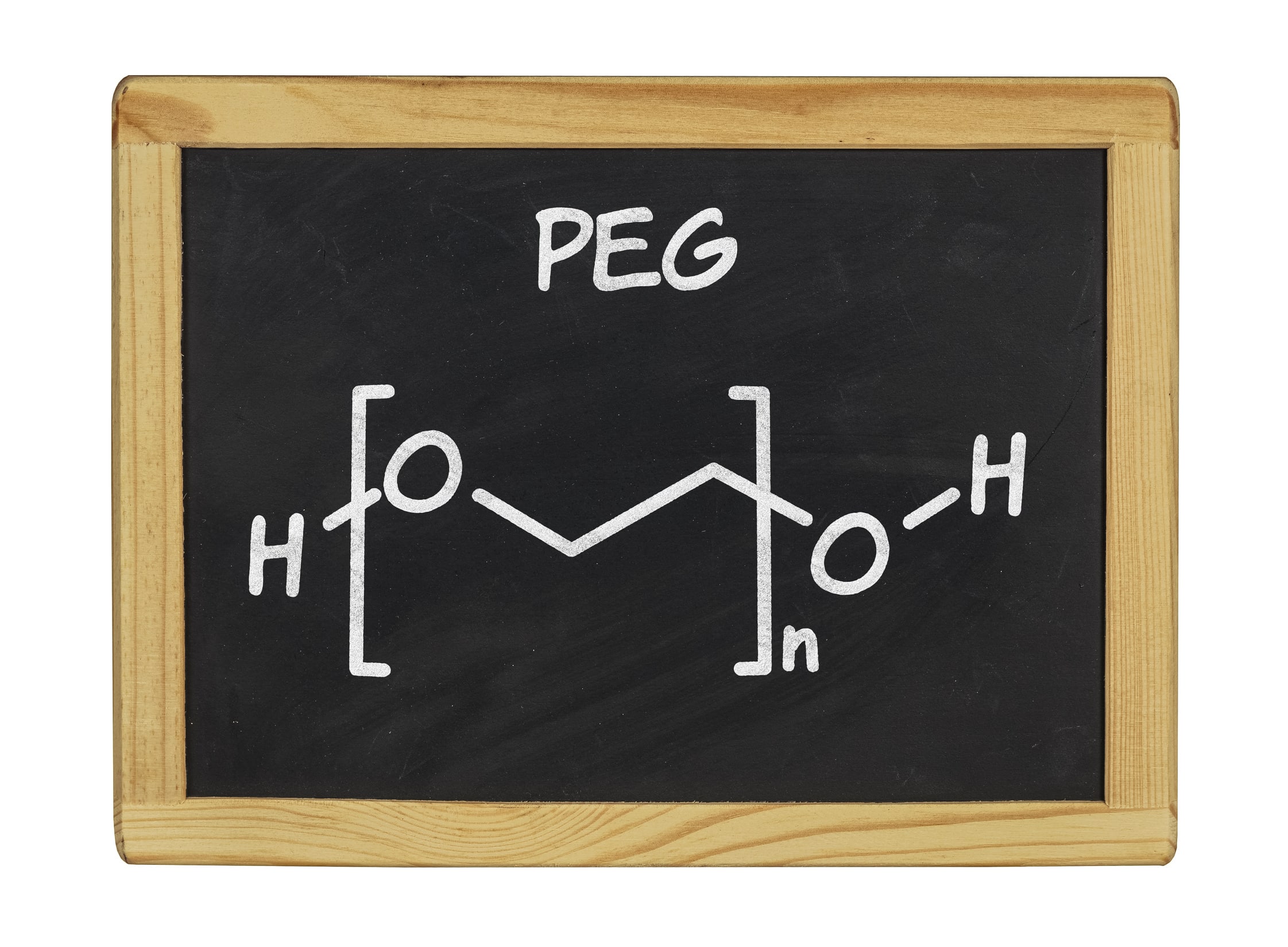Polyethylene glycol – versatile, inexpensive, but problematic

Polyethylene glycol is a synthetic raw material that has been used in countless formulations in the cosmetics industry for decades. The special feature of polyethylene glycol is its extreme versatility. Depending on its chain length and structure, the substance can take on a wide variety of properties: sometimes liquid, sometimes paste-like, sometimes solid. It is precisely this flexibility that makes polyethylene glycol so interesting for manufacturers.
The basic building block of polyethylene glycol is ethylene oxide, a petroleum derivative that is considered highly toxic, mutagenic and potentially carcinogenic. In the manufacturing process, ethylene oxide is polymerised to form polyethylene glycol. Although the substance is standard in many cosmetic applications, the health and environmental risks should not be underestimated.
Polyethylene glycol in cosmetics
Polyethylene glycol is used in numerous cosmetic products, including deodorants, hair care products, toothpastes, bath additives, creams and lotions.
Its main functions are as an emulsifier, solubiliser, surfactant, humectant and refatting agent. However, this wide range of applications comes with serious disadvantages. Polyethylene glycol promotes penetration, which means that the skin becomes more permeable – not only to desired active ingredients, but also to harmful substances. This allows toxins to enter the bloodstream more easily.
At the same time, polyethylene glycol weakens the skin’s own protective barrier. The consequences range from skin irritation and allergic reactions to increased susceptibility to environmental influences.
Another problem is that polyethylene glycol is not biodegradable. It remains on the skin’s surface until it is washed off, during which time it also attacks the skin’s natural protective layer. In the long term, this leads to dryness and skin damage, especially in sensitive or previously damaged skin.
New findings on polyethylene glycol
Recently, critical voices have been raised against polyethylene glycol, not only in the cosmetics sector. Research indicates that the production of PEG can generate by-products such as 1,4-dioxane, a substance classified as carcinogenic. Residues of ethylene oxide itself have also been found in PEG derivatives, further fuelling the health debate.
These polymeric glycols are also under scrutiny from an ecological perspective: as it is synthetic and often petroleum-based, it does not contribute to sustainable production chains and is not biodegradable. As a result, more and more consumers are questioning the use of polyethylene glycol in everyday products and demanding natural alternatives.
Nature-based raw materials such as lecithin, glycerol fatty acid esters or sugar-fatty acid combinations have already established themselves as gentle, compatible substitutes. These alternatives can perform emulsifier or surfactant functions without weakening the skin barrier or posing health risks.
Examples of well-known PEG’s
- PEG-8: Used as a humectant, often in toothpaste.
- PEG-200: Skin cleansing and emulsifying, but not suitable for natural cosmetics.
- PEG-10: Serves as an emulsifying additive, often derived from soy sterols.
- PEG-3350: Even used in medical laxatives because it binds water strongly.
- PEG-7: Often found in shampoos and shower gels, acts as an emulsifier and surfactant.
These examples show how widely polyethylene glycol is used in cosmetics – and why the debate about its safety and environmental compatibility is so important.
Alternatives to PEG’s
Fortunately, there are now numerous safe and skin-friendly alternatives available. These raw materials mostly come from renewable sources, are more environmentally friendly and are also recognised in natural cosmetics standards. Below is an overview of the most important alternatives:
Lecithin
- Origin: mostly from soy or sunflowers
- Function: emulsifier, skin care ingredient, moisture binder
- Special feature: identical to the skin, very good tolerance, strengthens the skin barrier
Glycerol fatty acid ester
- Origin: combination of vegetable glycerol and natural fatty acids
- Function: refatting agent, emulsifier, mild surfactant
- Special feature: prevents skin dryness, biodegradable
Sugar surfactants (e.g. coco-glucoside, decyl glucoside)
- Origin: from coconut oil and glucose (corn or potato starch)
- Function: mild surfactants, foaming agents, cleansing agents
- Special feature: very gentle on the skin, also suitable for sensitive skin, approved for use in natural cosmetics
Sorbitan esters (e.g. sorbitan olivate, sorbitan stearate)
- Origin: from sorbitol (sugar alcohol) and vegetable fatty acids
- Function: emulsifier, stabiliser
- Special feature: excellent skin compatibility, reliably stabilises O/W emulsions
Polyglycerol esters
- Origin: from polyglycerol and vegetable fatty acids
- Function: emulsifier, solubiliser
- Special feature: versatile, supports a stable emulsion structure, 100% plant-based
These examples show that modern formulations can easily do without PEG. They are not only gentler on the skin, but also more environmentally friendly and increasingly preferred by consumers.
Conclusion: Avoid PEG – use safe alternatives
Polyethylene glycol is cheap, versatile and extremely practical for manufacturers. For consumers, however, the disadvantages outweigh the benefits: potential health risks, skin irritation, weakening of the skin barrier and a lack of environmental sustainability. Products without polyethylene glycol are therefore generally preferable.
The cosmetics industry needs to rethink its approach – and that is exactly what we are doing:
We develop innovative formulations without polyethylene glycol. If you want to get started right away, our partner Tojo Cosmetics GmbH also offers numerous ready-to-go formulations that are completely free of polyethylene glycol and can be incorporated directly into your own product line.
Feel free to contact us – we will be happy to advise you in detail.